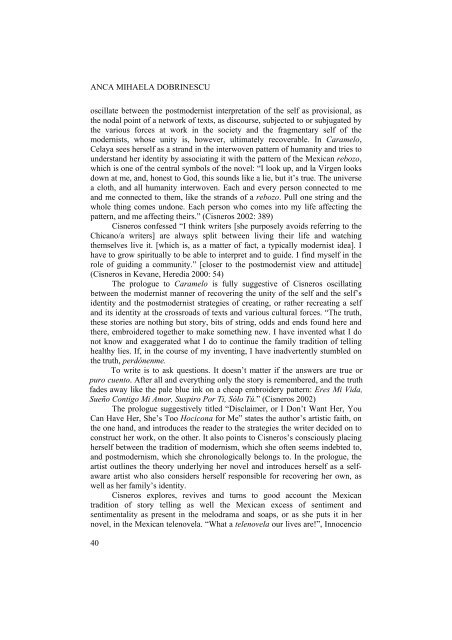culture, subculture and counterculture - Facultatea de Litere
culture, subculture and counterculture - Facultatea de Litere
culture, subculture and counterculture - Facultatea de Litere
Create successful ePaper yourself
Turn your PDF publications into a flip-book with our unique Google optimized e-Paper software.
ANCA MIHAELA DOBRINESCU<br />
oscillate between the postmo<strong>de</strong>rnist interpretation of the self as provisional, as<br />
the nodal point of a network of texts, as discourse, subjected to or subjugated by<br />
the various forces at work in the society <strong>and</strong> the fragmentary self of the<br />
mo<strong>de</strong>rnists, whose unity is, however, ultimately recoverable. In Caramelo,<br />
Celaya sees herself as a str<strong>and</strong> in the interwoven pattern of humanity <strong>and</strong> tries to<br />
un<strong>de</strong>rst<strong>and</strong> her i<strong>de</strong>ntity by associating it with the pattern of the Mexican rebozo,<br />
which is one of the central symbols of the novel: “I look up, <strong>and</strong> la Virgen looks<br />
down at me, <strong>and</strong>, honest to God, this sounds like a lie, but it’s true. The universe<br />
a cloth, <strong>and</strong> all humanity interwoven. Each <strong>and</strong> every person connected to me<br />
<strong>and</strong> me connected to them, like the str<strong>and</strong>s of a rebozo. Pull one string <strong>and</strong> the<br />
whole thing comes undone. Each person who comes into my life affecting the<br />
pattern, <strong>and</strong> me affecting theirs.” (Cisneros 2002: 389)<br />
Cisneros confessed “I think writers [she purposely avoids referring to the<br />
Chicano/a writers] are always split between living their life <strong>and</strong> watching<br />
themselves live it. [which is, as a matter of fact, a typically mo<strong>de</strong>rnist i<strong>de</strong>a]. I<br />
have to grow spiritually to be able to interpret <strong>and</strong> to gui<strong>de</strong>. I find myself in the<br />
role of guiding a community.” [closer to the postmo<strong>de</strong>rnist view <strong>and</strong> attitu<strong>de</strong>]<br />
(Cisneros in Kevane, Heredia 2000: 54)<br />
The prologue to Caramelo is fully suggestive of Cisneros oscillating<br />
between the mo<strong>de</strong>rnist manner of recovering the unity of the self <strong>and</strong> the self’s<br />
i<strong>de</strong>ntity <strong>and</strong> the postmo<strong>de</strong>rnist strategies of creating, or rather recreating a self<br />
<strong>and</strong> its i<strong>de</strong>ntity at the crossroads of texts <strong>and</strong> various cultural forces. “The truth,<br />
these stories are nothing but story, bits of string, odds <strong>and</strong> ends found here <strong>and</strong><br />
there, embroi<strong>de</strong>red together to make something new. I have invented what I do<br />
not know <strong>and</strong> exaggerated what I do to continue the family tradition of telling<br />
healthy lies. If, in the course of my inventing, I have inadvertently stumbled on<br />
the truth, perdónenme.<br />
To write is to ask questions. It doesn’t matter if the answers are true or<br />
puro cuento. After all <strong>and</strong> everything only the story is remembered, <strong>and</strong> the truth<br />
fa<strong>de</strong>s away like the pale blue ink on a cheap embroi<strong>de</strong>ry pattern: Eres Mi Vida,<br />
Sueño Contigo Mi Amor, Suspiro Por Ti, Sólo Tú.” (Cisneros 2002)<br />
The prologue suggestively titled “Disclaimer, or I Don’t Want Her, You<br />
Can Have Her, She’s Too Hocicona for Me” states the author’s artistic faith, on<br />
the one h<strong>and</strong>, <strong>and</strong> introduces the rea<strong>de</strong>r to the strategies the writer <strong>de</strong>ci<strong>de</strong>d on to<br />
construct her work, on the other. It also points to Cisneros’s consciously placing<br />
herself between the tradition of mo<strong>de</strong>rnism, which she often seems in<strong>de</strong>bted to,<br />
<strong>and</strong> postmo<strong>de</strong>rnism, which she chronologically belongs to. In the prologue, the<br />
artist outlines the theory un<strong>de</strong>rlying her novel <strong>and</strong> introduces herself as a selfaware<br />
artist who also consi<strong>de</strong>rs herself responsible for recovering her own, as<br />
well as her family’s i<strong>de</strong>ntity.<br />
Cisneros explores, revives <strong>and</strong> turns to good account the Mexican<br />
tradition of story telling as well the Mexican excess of sentiment <strong>and</strong><br />
sentimentality as present in the melodrama <strong>and</strong> soaps, or as she puts it in her<br />
novel, in the Mexican telenovela. “What a telenovela our lives are!”, Innocencio<br />
40












